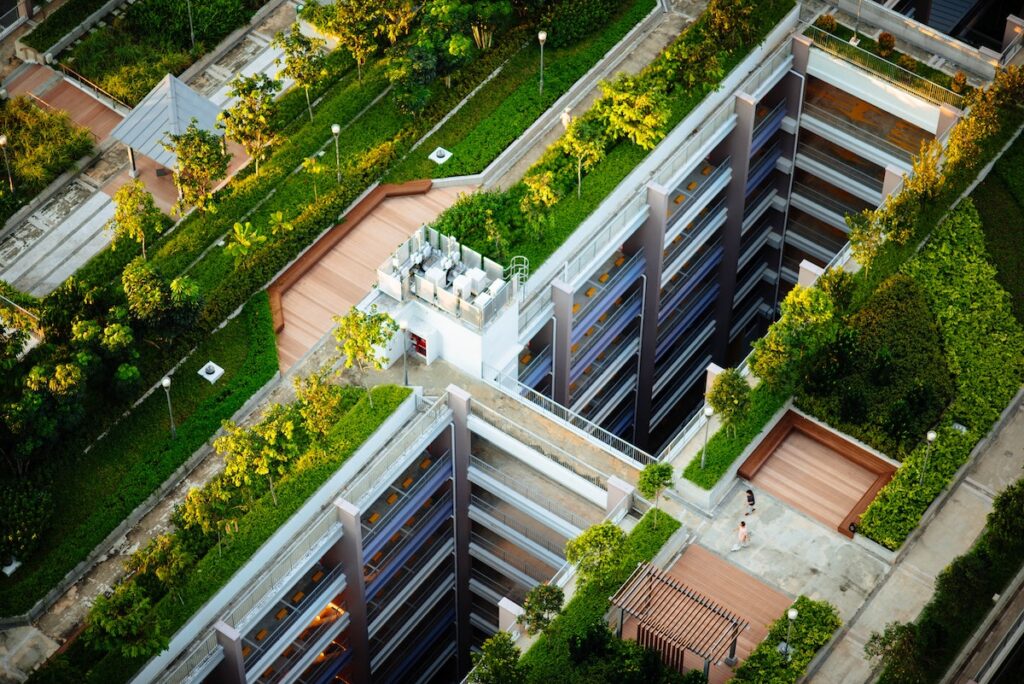Green smart cities
Courtesy : smartcity.press/
Green areas can be integrated into the architecture of smart cities, even where space is at a premium. For example, in Sydney, Australia, One Central Park is a luxury apartment complex intentionally covered in plant life. A park is situated at the base of the two towers, with vegetation climbing both buildings. These plants lower the structures’ electricity and water consumption through recycling and natural insulation.
Biomimetic design, which draws inspiration from the environment, also offers opportunities for smart cities to bring in more of the natural world. Nature has developed countless ways to deal with airflow, heating and cooling. By looking to the world’s existing green spaces for inspiration, architects can design smart cities that utilize nature just as much as electronic technology.
For example, an apartment building in Hamburg, Germany, uses glass panes with alga to naturally maintain indoor temperatures. The algae also produce renewable methane and biofuel, which powers the building’s electricity.
Improving Citizens’ Lives
Greenery and plant life have been proven to have numerous health benefits, which could be instrumental in building smart cities that truly improve the quality of life. Indoor and outdoor plants can reduce depression and anxiety, improve productivity, increase creativity, boost self-esteem and even reduce symptoms of dementia.
Green spaces can be used in various ways to make smart cities happy, healthy places to live. Experts have pointed out that vertical farms can provide locally grown produce. These fruits and vegetables would be healthier and less expensive than imported foods. Biomimetic design could be applied to the vertical farms to give them additional functionality on buildings, providing shade, insulation and potentially even biofuels.
Advertisement

Similarly, local governments can invest in sustainable campgrounds near smart cities. This would provide access to immersive green spaces and opportunities for smart city-dwellers to learn even more about sustainability and nature. Easy access to campgrounds and national parks also encourages people to take a break and get outdoors, which can lead to the above-mentioned health benefits.
In fact, the United Nations has identified access to green spaces as key to improving urban health, especially for socioeconomically disadvantaged groups. UN research has found that these people tend to benefit most from access to nature. Making it affordable and convenient for families of any economic standing to visit a nature trail or campground could help alleviate the health impact of financial and social stress.
Smart city tech can even be used to nurture existing urban green spaces. City planners can use smart sensors to create efficient automated irrigation systems around parks. Similarly, mesh Wi-Fi networks allow for reliable connectivity through existing green spaces without infrastructure overhauls. This enables the use of smart security systems and interactive digital experiences, such as virtually led nature walks.
Sustainably Smart Cities
Today’s cities consume an estimated 78% of the world’s energy but produce over 60% of greenhouse gas emissions. Sustainability must be addressed for smart cities to achieve their goals and genuinely improve urban life. Prioritizing green spaces is the first step to accomplishing this.
Increasing the presence of green spaces in smart cities will go a long way toward helping wildlife. Animals are increasingly threatened by urbanization. This problem will only get worse as climate change slowly damages ecosystems.
Many species of animals have adapted to city habitats. This tends to be highly dependent on several factors, such as temperature and food chain competition. Smart cities must include refuges for plants and animals to protect the ecosystems around cities. Keeping these areas stable will organically help urban greenery flourish, which will, in turn, help citizens thrive.
Plants absorb CO2, so green spaces will help clean urban air and neutralize emissions. Using greenery to insulate buildings will lower pollution and keep cities cooler. Vertical gardens mean less produce will be shipped into cities, reducing their carbon footprint.
The Future of Cities Is Green
The possibilities are truly endless when it comes to greenery in smart city design. The urban world is becoming more advanced and connected, so city planners must remember the importance of nature. Green spaces are at the heart of what smart cities strive for: an opportunity for everyone to thrive.





